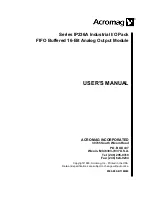
SERIES IP236A INDUSTRIAL I/O PACK FIFO BUFFERED 16 BIT ANALOG OUTPUT MODULE
___________________________________________________________________________________________
- 3 -
Model
Analog Output
Channels
FIFO Buffer Per
Channel
Temperature
Range
IP236A-8
8
Yes
0 to +70 C
IP236A-8E
8
Yes
-40 C to +85 C
KEY IP236A FEATURES
DAC 16-Bit Resolution
- 16-bit monolithic DAC with bipolar
voltage output ranges of 10V, 5V, and an unipolar output
range of 0 to 10V. The IP236A-8 will have eight
independently controlled DACs present on the board.
10 sec Conversion Time
- A maximum recommended
conversion rate of 100KHz, for specified accuracy, is
supported. The absolute maximum conversion rate of
150KHz is also supported.
128-Sample FIFO Buffers -
Each DAC channel provides
128-sample data buffering to reduce CPU interactions and
interrupts. This allows the external processor to handle
more tasks within a given time.
Continuous Conversion Mode -
Each of the channel’s
FIFOs can be filled/loaded with new data without stopping
output waveform generation.
Single Step Mode
- On each new software or external
trigger, each output channel can be independently updated
with a new DAC value read from their corresponding FIFO
buffer.
Interrupt Support -
Individually controlled FIFO almost
empty interrupts may be generated. Unique interrupt
thresholds can be assigned to each channel. On a FIFO
almost empty interrupt, the interrupt service routine could fill
the FIFO with new data while output waveform generation
continues. Thus, allowing continuous conversions.
User Programmable Interval Timer
- Each channel has a
user programmable interval timer provided to control the
delay between conversions. Each channel is independently
converted at the rate set by its corresponding interval timer.
This feature supports a minimum interval of 6.7 sec and a
maximum interval of 2.09 seconds.
FIFO Full and Almost Empty Flags-
Individual FIFO Full
and Almost Empty flag bits are available to implement
software polling schemes for FIFO buffer data control.
External Trigger Scan Mode
- Each channel has an
external trigger which is assigned to a field I/O line. Thus,
all channels can independently initiate a new conversion
with each external trigger via its dedicated external trigger
pin. This mode allows synchronization of conversions with
external events that are often asynchronous.
External Trigger Output
- The external trigger may be
configured as an output signal to provide a means to
synchronize other channels or IP236A devices to a single
IP236A channel or module.
Reliable Software Calibration
- Calibration coefficients
stored on-board provide the means for accurate software
calibration for both gain and offset correction for each of the
channels of the module.
Reset is Failsafe For Bipolar Output Ranges -
When the
module’s jumpers are set for bipolar operation, the analog
outputs are reset to 0 volts upon power up or receipt of a
software or hardware reset. This eliminates the problem of
applying random output voltages to actuators during power
on sequences.
Hardware Jumper Setting For Selection of DAC Ranges
-
Both bipolar ( 5V, 10V) and unipolar (0 to 10V) ranges are
available. The ranges can be selected on a per channel
basis.
High Density
- Provides programmable control of eight
analog voltage output channels. Four units mounted on a
VMEbus or ISAbus carrier board provide 32 DAC channels
in a single system slot. On the PCIbus carrier, up to five
units may be mounted to provide up to 40 DAC channels per
PCI system slot.
Extended Temperature Performance Option -
Model
IP236A-8E unit support operation from -40 C to +85 C.
INDUSTRIAL I/O PACK INTERFACE FEATURES
High density -
Single-size, industry standard, IP module
footprint. Four/five units mounted on a carrier board provide
up to 32/40 serial ports in a single system slot.
Local ID
- Each IP module has its own 8-bit ID information
which is accessed via data transfers in the "ID Read" space.
16-bit and 8-bit I/O
- Port register Read/Write is performed
through data transfer cycles in the IP module I/O space.
High Speed
- Access times for all data transfer cycles are
described in terms of "wait" states - 0 wait state is required
for reading and writing all control registers and ID values.
Interrupt select cycles also require 0 wait states for reading
the interrupt vector. Two wait states are typically required to
write the channel data FIFO ports (see the Specifications
section for detailed information).
SIGNAL INTERFACE PRODUCTS
(See Appendix for more information on compatible products)
This IP module will mate directly to any industry standard IP
carrier board (including Acromag’s AVME9630/9660 3U/6U
VMEbus carrier boards). Additionally, PC/AT carrier boards are
also supported (see the Acromag Model APC8620 PCIbus carrier
board). A wide range of other Acromag IP modules are available
to serve your signal conditioning and interface needs.
The cables and termination panels, described in the following
paragraphs, are also available. For optimum performance with
the 16-bit IP236A analog output modules, use of the shortest
possible length of shielded output cable is recommended. Since
all connections to field signals are made through the carrier board
which passes them to the individual IP modules, you should
consult the documentation of your carrier board to ensure
compatibility with the following interface products.
Cables:
Model 5025-551-X (Shielded Cable), or Model 5025-550-X
(Non-Shielded Cable): A Flat 50-pin cable with female
connectors at both ends for connecting AVME9630/9660,
APC8610, or APC8620 carrier boards, to Model 5025-552
termination panels. The unshielded cable is recommended
for digital I/O, while the shielded cable is recommended for
optimum performance with precision analog I/O applications.
The “-X” suffix of the model number is used to indicate the
length in feet.




































